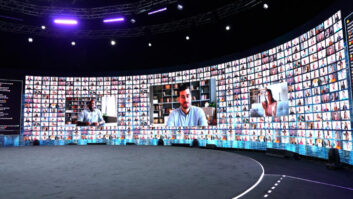
Having previously detailed the technology areas with significant overlap between broadcast and AV, we conclude this feature by looking at the pros and cons of multi-use products and considering what it all means for integrators.
Given a convergence between the two industries that has only accelerated over the past 12-18 months, the question has to be asked whether we’ll see increasing commonality of products, with manufacturers finding that they can readily address what were once disparate opportunities?
“It’s much more common now for a product to be multi-use,” claims Jason Pruett, product marketing manager at NewTek. “Broadcasters and AV professionals are much more flexible in terms of what they are comfortable working with, but, more importantly, the delivery models and mechanisms are much more flexible. We no longer live in an era where professional video production is the domain of multimedia conglomerates and corporations. If your production model is designed for streaming or social media, for example, you have a wealth of options from using consumer-grade devices to using professional video systems, to using both at the same time. It all depends on the user and what the application for a product actually is.”
“It’s absolutely possible to develop products for both markets,” says Andy Fliss, VP sales and marketing at tvONE. “tvONE has been producing high-end format conversion devices for more than 30 years. The cross conversion between SDI and TMDS has been available for a long time. Now, we’re adding the cross conversion and encoding for streaming to the mix.”
Juggling both worlds
“For anyone working in IP video, being able to juggle both worlds is fundamental,” says Mike Allan, CTO at Exterity. “Ultimately, the challenge is to support the right standards, whether for live distribution or content protection. This is why, for example, Exterity’s product portfolio includes IP-to-SDI, SDI-to-IP and uncompressed IP-to-IP encoders that enable content transfer between streaming and broadcast environments.”
The broadcast industry has always been proud of its overriding commitment to ultimate image quality and the optimum consumer experience – and Button believes that this can benefit the AV world.
“AJA will always start with the broadcaster as the base since their demands are non-negotiable and require low-latency, reliability and robustness that is second to none,” he explains. “Developing to these demands makes it easier for us to supply crossover technologies to the AV business, and the AV business becomes the benefactor of that initial drive.”
Atkins is somewhat more cautious, however. “Yes, in some areas, the needs of AV and broadcast have much in common,” he considers. “However, it’s important that products are fit for purpose – and there’s little point in trying to suit everyone and, in the process, suiting no-one.”
Opportunities – and challenges
So: what does all this mean for the integrator? Inevitably, there are both opportunities – and challenges.
“Even with growing broadcast and AV technology convergence, the role of the integrator is still critical,” says Exterity’s Allan. “Selection of the right product for the right application is key. Despite convergence, many broadcast tools are still beyond the pocket or skills of many other organisations. The integrator has to choose the right technology and right tools for the problem to be solved; uncompressed video distribution for those high quality low latency needs to be run on separate high performance networks or H.264-encoded distribution over typical lower cost, lower performance multi-application corporate networks in order to reach the majority in the organisation.”
“Integrators should strive to work with vendors that are embracing open standards while making it easy to integrate with third party applications to deliver flexible solutions,” he goes on. “This ability to adapt is vital, as newer requirements such as 4K, AR, VR and interactivity are starting to move from drawing board to commercialised products.”
Jamie Adkin, vice president, sales EMEA at KVM company Adder Technology, sees things similarly. “In recent times, we’ve seen integrators excelling when they have capability on both the broadcast and AV side, and then getting more involved in both mainstream and niche environments that demand capabilities in both,” he recalls. “This means that, in the future, it’s going to be critical that both integrators and distributors develop a much broader knowledge of the technologies. This will mean acquiring a wider understanding of the whole market, rather than just the products they represent.”
Spoiled for choice
Bryce Button, director of product marketing at AJA Video Systems, perceives mostly opportunities. “Increasingly, integrators are being spoiled for choice, with a wider array of high quality products designed for the rough and ready nature of live broadcast, and emerging technologies like IP for video with a range of different approaches to accommodate both AV and pro broadcast workflows,” he believes. “There’s an ever-expanding supply of methodologies available on the broadcast side; organisations like AIMS and SMPTE; approaches like NDI; and other approaches to IP that are ever evolving and provide choices for AV implementations.”
NewTek’s Pruett has some words of advice. “Buyers are becoming increasingly more knowledgeable, increasingly more discerning,” he says, “and as they continue to explore new possibilities in terms of technologies on their own, AV suppliers and integrators need to be prepared to match wits once those buyers engage them in conversation. Technology is advancing so fast and becoming so convergent, AV suppliers and integrators must continue to further their education in their markets of expertise – and that includes learning about, and getting accustomed to, working with technologies they would have once considered exclusive to broadcast.”
It turns out, then, that, as things stand, the AV and broadcast industries are not only converging – they have been converging with increased rapidity over the past year or so. But: differences between the two still exist, even as they become more similar. There has, for example, been a far more concerted effort in the broadcast industry to develop rigorous standards for IP transport – standards that may migrate to the AV industry, although that’s far from clear.
Enormous momentum
Adkin has it about right when he points out that it’s not so much a question of broadcast and AV converging: it’s more a question of both converging with the world of IT. That process is inexorable, with enormous momentum continuing to carry it forward.
Will IBC and ISE continue to be viable as separate shows? Who knows? Both are seeing growth in visitor numbers (at a time when visitor numbers for the world’s largest IT show, CeBIT, are in decline). And there, perhaps, lies the answer. For all that the underlying technologies may be becoming increasingly indistinguishable (and IP is bringing a world of new opportunities to both broadcast and AV, and increasing numbers of products are becoming viable for both environments) what’s always been important, and will continue to be important, is the application – the use case. From that point of view, the two industries, far from converging, will remain completely distinct.
www.adder.com
www.aja.com
www.exterity.com
www.newtek.com
www.tvone.com







